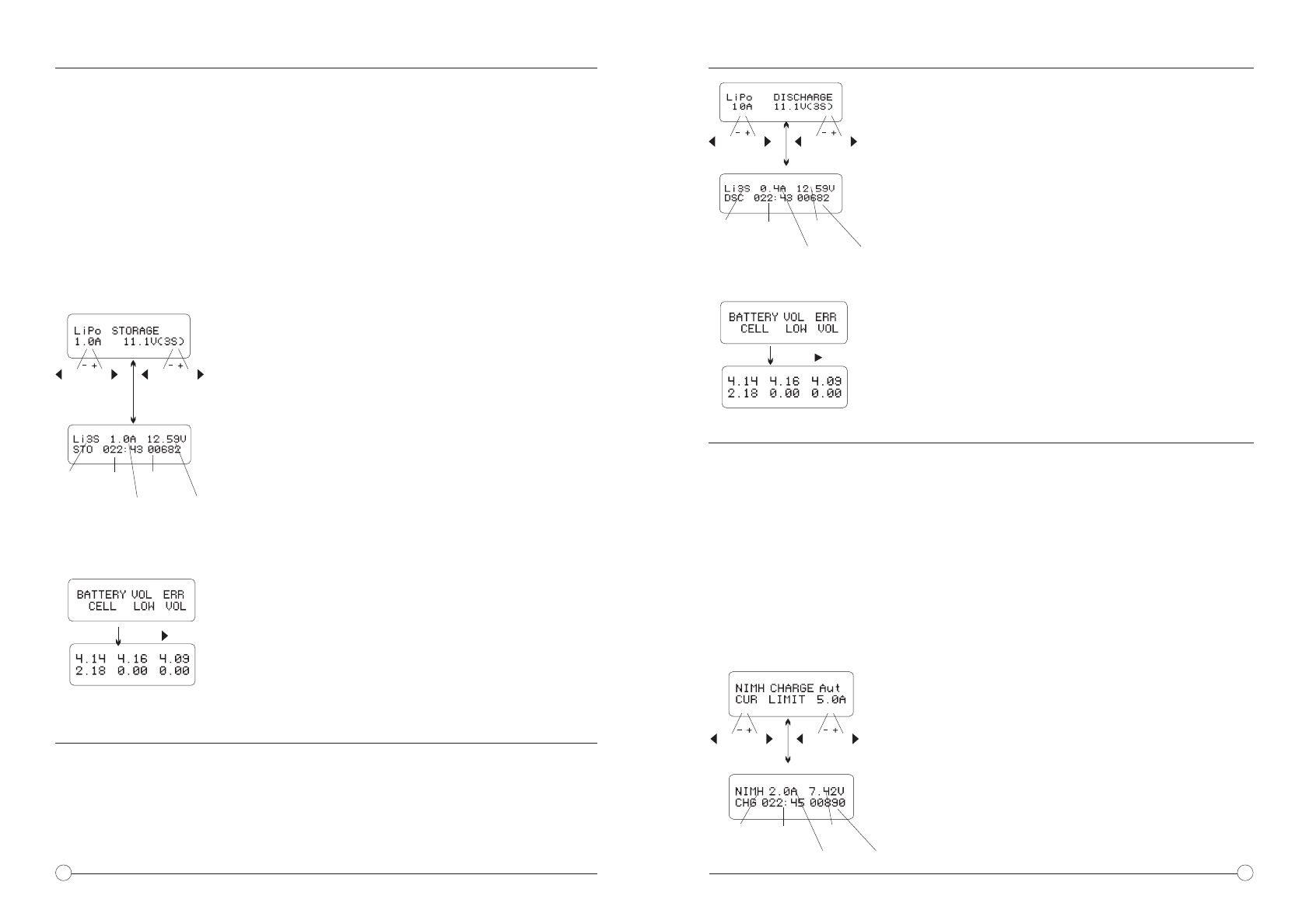Manual

17
16
This screen, you can set up the current and voltage of the
battery pack. Charging and discharging will bring the batter-
ies to the storage level.
This screen shows the real-time status of the charge or
discharge process. Press the BATT TYPE/STOP key once to
stop the charging process.
The setting of the discharge current on the left cannot exceed
1C, and the setting on the right cannot be under the voltage
recommended by the manufacturer to avoid deep discharg-
ing. Press the START/ENTER key for more than 3 seconds to
start discharging.
This shows the real-time status of discharging; you can press
the BATT TYPE/STOP key to stop discharging.
Charging NiCd or NiMh Batteries
This program is for charging NiCd/NiMH batteries typically
used in an R/C model application. Press the START/ENTER
key until the parameter you want to change begins to blink
then use the INC or DEC keys to change the value. Press the
START/ENTER key to store the setting.
This screen shows the real-time status of charging. You can
press the BATT TYPE/STOP key to stop the charge process.
NOTE
During the discharge process the X4 AC Plus’s Microprocessor monitors the voltage of
each cell during the Storage Mode or Discharge process. If the voltage of any cell is
abnormal, the charger will display an error message and immediately terminate the
program. Before disconnecting the battery review the error message then press the INC
button to display which cell is.
Charging Lithium Batteries in the Storage Mode
The Storage Mode function is for charging/discharging batteries that will not be used
immediately or that will be stored for a period of time. The program is designed for charg-
ing or discharging batteries to a specific voltage level depending on the type of battery
(Li-ion = 3.75V, LiPo = 3.85V and LiFe = 3.3V) The program will begin to discharge if the
original state of the battery exceeds the voltage level for storage.
Lithium batteries are recommended to be discharged partially rather than fully. Frequent
full discharging should be avoided if at all possible. Instead, charge the battery more often
or use a battery of larger capacity. Full capacity cannot be reached until it has been
subjected to 10 or more charge cycles. The cyclic process of charge and discharge will
optimize the capacity of the battery pack.
There are two methods of charging NiCD and NiMh batteries, Manual or Auto Mode. When
in the NiMh or NiCd Program Select screen you can change modes by pressing the
START/ENTER key until the current field begins flashing then press INC and DEC simulta-
neously to switch between Auto and Manual Mode. using the charge current you set up. In
the “auto” mode, you should set the upper limit of the charge current to avoid damage caused
by excessive charge current. This is especially important for low quality batteries that have
low resistance and capacity. In the “manual mode” the charger will only charge at the current
you set. Note the following charger / discharge specifications for NiCd and NiMh Batteries.
Nominal Voltage level: 1.2V/cell
Allowable Fast Charge Current: 1C-2C (depends on performance of cell)
Discharge Voltage Cut Off Level NiCd: 0.85V per cell
Discharge Voltage Cut Off Level NiMh: 1.0V per cell
Error Message Display
CHARGING/ DISCHARGING AND CYCLING NiCd OR NiMh BATTERIES
This screen shows that the processor detected the voltage of
one on the cells is too low.
This screen shows the 4th cell was damaged. If the cell is
disconnected or not present the reading of the voltage will be
zero.
Error Message Display
INC
This screen shows that the processor detected the voltage of
one on the cells is too low.
This screen shows the 4th cell was damaged. If the cell is
disconnected or not present the reading of the voltage will be
zero.
CHARGING LITHIUM CHEMISTRY (LiPo/Lilo/LiFe) TYPE BATTERIES
DISCHARGING LITHIUM CHEMISTRY (LiPo/Lilo/LiFe) TYPE BATTERIES
DISCHARGING LITHIUM CHEMISTRY (LiPo/Lilo/LiFe) TYPE BATTERIES
Number
of Cells
Charge or
Discarge
Current
Battery
Voltage
Supplied
Capacity
Elapsed
Time
DEC INC DEC INC
DEC INC DEC INC
‘>3 seconds’
Batt Type
Stop
Start
Enter
INC
‘>3 seconds’
Batt Type
Stop
Start
Enter
Number
of Cells
Elapsed
Time
Discharge
Current
Battery
Voltage
Discharged
Capacity
DEC INC DEC INC
‘>3 seconds’
Batt Type
Stop
Start
Enter
Battery
Type
Elapsed
Time
Charge
Current
Battery
Voltage
Charged
Capacity










